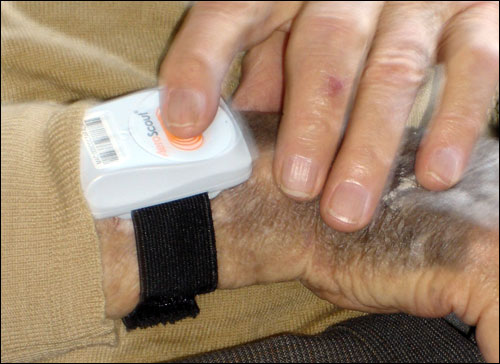Samarinda Aged Services, an Australian elder-care provider based in Melbourne, has improved the safety of its residents and the productivity of its staff through a Wi-Fi-based RFID system enabling it to monitor residents and equipment.
The company is employing active Wi-Fi-based RFID tags and software from real-time location system (RTLS) provider AeroScout to track residents inside and outside one its facilities, known as Samarinda Lodge. The tags are also equipped with a button that residents can press to call for help.

The system has already helped improve staff response times and resident safety, the company reports, as well as increasing employee productivity and retention rates. What’s more, the amount of time workers spent walking between tasks has been reduced from 10 percent to 4 percent, and the time dedicated to resident care has increased from 51 percent to 68 percent. This, according to Samarinda Lodge, has led to increased staff satisfaction, and retention rates have risen to 25 percent above the industry average
Faced with limited resources in the aged-care industry, Samarinda’s chief executive, Tanya Gilchrist, wanted a system that would reduce the time employees spent searching for residents and equipment, so that the time allotted for resident care would be maximized.
RFID has previously been used in the aged-care industry. In 2007, Queensland-based PresCare also rolled out a Wi-Fi-based system from AeroScout, to track residents and alert staff members through a tag affixed to lanyards worn around the neck (see Wi-Fi-Based RFID Improves Elderly Care). Last year, residents at Dogwood Village’s assisted-living facility in Virginia were provided with RFID-enabled pendants to summon aid (see Answering the Call at Senior Care Facility). Also last year, a Florida care home sewed passive tags into its 70 residents’ clothing, so that the staff would be alerted if any residents attempted to leave the premises (see RFID Gives Dementia Patients Their Freedom). But Samarinda’s system has combined monitoring residents with an alert system and asset tracking.
Samarinda conducted studies, which indicated that workers spent more than two hours each day searching for personnel, residents and equipment. “The study showed us that we needed to improve our communication systems and reduce the amount of time staff spent walking around, looking for each other, resources and residents,” Gilchrist explains. “So we worked in conjunction with IBM to implement an integrated communication system to address the problem.”
Samarinda Lodge first implemented Vocera‘s communications system, a wireless voice over IP (VoIP) network that enables staff members to communicate hands-free with other workers anywhere on the facility’s Wi-Fi network, using a Vocera Wi-F9 communications badge—a clip-on, voice-controlled device with a microphone and a speaker. Residents were also provided with Cisco 7921G Wi-Fi-based wireless telephones in their rooms, configured to answer on speaker from internally generated calls.
Samarinda then introduced AeroScout’s Wi-Fi-based RFID system, utilizing the facility’s existing Cisco Unified Wireless Network. AeroScout T2 battery-powered tags transmit an identification number via a 2.4 GHz signal. The information, received by standard Wi-Fi access points, is then sent over Ethernet to AeroScout’s MobileView software, which calculates tag locations and boasts sophisticated mapping, searching, alerting and reporting capabilities.
Each resident is provided with an AeroScout Wi-Fi tag that has a button for requesting assistance. A resident in need of help can press the call button on his or her tag, which is fastened to that person’s wrist via an elastic band. Employees can then access the MobileView software via a computer monitor to quickly locate the individual who pressed the button.
“Because our wireless network extends around the block,” Gilchrist says, “residents who are physically able can now take a daily walk around the block, secure in the knowledge that they can alert staff who will be able to locate them if they fell or were unable to complete the walk.”
By responding faster to residents’ needs and requests, the facility has seen fewer falls, as residents are now less likely to attempt to get out of a bed or chair when they shouldn’t, if they are confident help will arrive quickly.
AeroScout tags were also attached to shower trolleys, lifting equipment and wheelchairs, allowing employees to quickly search for and locate equipment when needed, thereby leading to improved staff times and productivity.
“We spent a great deal of time ensuring that we understood the work patterns of staff, how they interacted with residents and each other, and what information they needed to know, and then configuring the technology to integrate it as seamlessly as possible,” Gilchrist states. “We were not looking to change how nurses worked, or how residents requested staff assistance, but rather to provide seamless, almost invisible technological improvements. The system was deployed live across the facility in a day, following compulsory education held three times each day for a week.”
According to Gilchrist, the benefits have gone beyond what Samarinda Lodge expected, with versatility, flexibility and mobility being the greatest payback.
“It benefits residents through improved care, response time, sense of security, reduced anxiety and greater confidence in being independent,” she says. “For staff, it reduces time wasted looking for residents and equipment, improves the management of emergencies, improves staff morale, and increases direct communication between staff.”
What’s more, Gilchrist notes, the system has helped Samarinda improve its efficiency and productivity, as well as recruitment and retention.
“We expect a return on investment in less than a year, as the annual return on staff efficiency improvements exceeds the capital cost,” Gilchrist says. “We can also leverage the existing infrastructure across other systems. I have a long list for utilizing the system more fully, such as enhancing security of clients with dementia. For example, when a person with dementia is not where they are supposed to be, AeroScout’s solution can locate the person. In addition, it can be set up to trigger an alert if a person leaves a defined area or enters a restricted zone, and an alert is sent to staff warning them that someone may be wandering or eloping.”

